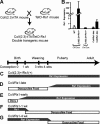Gs G protein-coupled receptor signaling in osteoblasts elicits age-dependent effects on bone formation
- PMID: 20200944
- PMCID: PMC3153396
- DOI: 10.1002/jbmr.3
Gs G protein-coupled receptor signaling in osteoblasts elicits age-dependent effects on bone formation
Abstract
Age-dependent changes in skeletal growth are important for regulating skeletal expansion and determining peak bone mass. However, how G protein-coupled receptors (GPCRs) regulate these changes is poorly understood. Previously, we described a mouse model expressing Rs1, an engineered receptor with high basal G(s) activity. Rs1 expression in osteoblasts induced a dramatic age-dependent increase in trabecular bone with features resembling fibrous dysplasia. To further investigate how activation of the G(s)-GPCR pathway affects bone formation at different ages, we used the tetracycline-inducible system in the ColI(2.3)(+)/Rs1(+) mouse model to control the timing of Rs1 expression. We found that the Rs1 phenotype developed rapidly between postnatal days 4 and 6, that delayed Rs1 expression resulted in attenuation of the Rs1 phenotype, and that the Rs1-induced bone growth and deformities were markedly reversed when Rs1 expression was suppressed in adult mice. These findings suggest a distinct window of increased osteoblast responsiveness to G(s) signaling during the early postnatal period. In addition, adult bones encode information about their normal shape and structure independently from mechanisms regulating bone expansion. Finally, our model provides a powerful tool for investigating the effects of continuous G(s)-GPCR signaling on dynamic bone growth and remodeling.
Copyright 2010 American Society for Bone and Mineral Research.
Figures







Similar articles
-
Ligand-mediated activation of an engineered gs g protein-coupled receptor in osteoblasts increases trabecular bone formation.Mol Endocrinol. 2010 Mar;24(3):621-31. doi: 10.1210/me.2009-0424. Epub 2010 Feb 11. Mol Endocrinol. 2010. PMID: 20150184 Free PMC article.
-
Assessing the osteoblast transcriptome in a model of enhanced bone formation due to constitutive Gs-G protein signaling in osteoblasts.Exp Cell Res. 2015 May 1;333(2):289-302. doi: 10.1016/j.yexcr.2015.02.009. Epub 2015 Feb 20. Exp Cell Res. 2015. PMID: 25704759 Free PMC article.
-
Increased Gs Signaling in Osteoblasts Reduces Bone Marrow and Whole-Body Adiposity in Male Mice.Endocrinology. 2016 Apr;157(4):1481-94. doi: 10.1210/en.2015-1867. Epub 2016 Feb 22. Endocrinology. 2016. PMID: 26901092 Free PMC article.
-
Gs/Gi Regulation of Bone Cell Differentiation: Review and Insights from Engineered Receptors.Horm Metab Res. 2016 Nov;48(11):689-699. doi: 10.1055/s-0042-116156. Epub 2016 Sep 19. Horm Metab Res. 2016. PMID: 27643449 Review.
-
G Protein and its signaling pathway in bone development and disease.Front Biosci (Landmark Ed). 2010 Jun 1;15(3):957-85. doi: 10.2741/3656. Front Biosci (Landmark Ed). 2010. PMID: 20515736 Review.
Cited by
-
Advances in Models of Fibrous Dysplasia/McCune-Albright Syndrome.Front Endocrinol (Lausanne). 2020 Jan 24;10:925. doi: 10.3389/fendo.2019.00925. eCollection 2019. Front Endocrinol (Lausanne). 2020. PMID: 32038487 Free PMC article. Review.
-
Osteoblast-derived FGF9 regulates skeletal homeostasis.Bone. 2017 May;98:18-25. doi: 10.1016/j.bone.2016.12.005. Epub 2017 Feb 9. Bone. 2017. PMID: 28189801 Free PMC article.
-
Protein kinase A is a dependent factor and therapeutic target in mouse models of fibrous dysplasia.Nat Commun. 2025 Jul 1;16(1):5425. doi: 10.1038/s41467-025-61402-z. Nat Commun. 2025. PMID: 40593719 Free PMC article.
-
Blockade of Gi Signaling Enhances the Anabolic Effect of Parathyroid Hormone in Female Mice.Calcif Tissue Int. 2025 Jul 16;116(1):98. doi: 10.1007/s00223-025-01409-2. Calcif Tissue Int. 2025. PMID: 40668360 Free PMC article.
-
The complex ontogenetic trajectory of mandibular shape in a laboratory mouse.J Anat. 2013 Dec;223(6):568-80. doi: 10.1111/joa.12118. Epub 2013 Sep 23. J Anat. 2013. PMID: 24111948 Free PMC article.
References
-
- National Osteoporosis Foundation. America's Bone Health: The State of Osteoporosis and Low Bone Mass in Our Nation. Washington: National Osteoporosis Foundation; 2002.
-
- MacKelvie KJ, Khan KM, Petit MA, Janssen PA, McKay HA. A school-based exercise intervention elicits substantial bone health benefits: a 2-year randomized controlled trial in girls. Pediatrics. 2003;112:e447. - PubMed
-
- Cooper C, Harvey N, Javaid K, Hanson M, Dennison E. Growth and bone development. Nestle Nutr Workshop Ser Pediatr Program. 2008;61:53–68. - PubMed
-
- Cooper C, Westlake S, Harvey N, Javaid K, Dennison E, Hanson M. Developmental origins of osteoporotic fracture. Osteoporos Int. 2006;17:337–347. - PubMed
-
- Aubin JE, Lian JB, Stein GS. Bone Formation: Maturation and Functional Activities of Osteoblast Lineage Cells. In: Favus MJ, editor. Primer on the Metabolic Bone Diseases and Disorders of Mineral Metabolism. 6th ed. Washington: American Society for Bone and Mineral Research; 2006. pp. 20–29.
Publication types
MeSH terms
Substances
Grants and funding
LinkOut - more resources
Full Text Sources
Molecular Biology Databases

